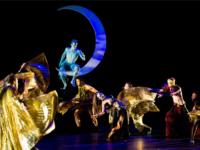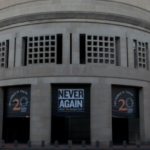

Virginia
George Washington Masonic Memorial
The George Washington Masonic Memorial was built in the 1920s by the more than two million American Freemasons who wished to
“express in durability and beauty the undying esteem of the Freemasons of the United States for him in whose memory it shall stand throughout the coming years.”
This magnificent structure is privately funded through the grateful contributions of Freemasons and others, and remains open to the public, seven days a week.
The George Washington Masonic Memorial is more than a colossal memorial and museum. It is a tourist attraction and destination; research center and library; community center; performing arts center and concert hall; banquet and celebration site; and meeting site for local and countless visiting Masonic lodges and organizations. However, first and foremost, it is a memorial to honor and perpetuate the memory, character and virtues of the man who best exemplifies what Freemasons are and ought to be, Brother George Washington. Lean more…
George Washington Mount Vernon Estate
George Washington, Commander-in-Chief of American forces in the Revolutionary War and the first President of the United States, called Mount Vernon home for more than 40 years. George Washington and his wife Martha Washington lived at Mount Vernon, which is now the most popular historic estate in America. Situated along the Potomac River in Northern Virginia, Mount Vernon is just 16 miles south of Washington, D.C.
Today, guests to Mount Vernon can visit the Mansion, more than a dozen original structures, Washington’s Tomb, and nearly 50 acres of his extensive plantation. The estate also includes a working blacksmith shop and the George Washington: Pioneer Farmer site, a 4-acre demonstration farm with a reconstructed slave cabin and 16-sided treading barn.
The Ford Orientation Center features an inspiring film, We Fight To Be Free. The Donald W. Reynolds Museum and Education Center is home to 25 theaters and galleries, which tell the detailed story of George Washington’s life with more than 500 original artifacts, 11 video presentations, and even an immersion theater experience.
Just 3 miles down the road from the Mansion, George Washington’s Distillery and Gristmill have been reconstructed and are open seasonally. Both fully functioning, Washington’s fascinating mill and distillery tell their story of Washington as a master entrepreneur.
Mount Vernon is an American landmark and a lasting reminder of the life and legacy of the Father of Our Country. Visit Mount Vernon, and discover the real George Washington. Read more…
Arlington National Cemetery
The Army National Cemeteries Program, consisting of Arlington National Cemetery in Arlington, Virginia and Soldiers’ and Airmen’s Home National Cemetery in Washington, DC, are under the jurisdiction of the Department of the Army. The Secretary of the Army consolidated authorities and created the Executive Director of the Army National Cemeteries Program to effectively and efficiently develop, operate manage and administer the program.
Arlington National Cemetery performs 27 to 30 funeral services each day. The grounds of Arlington National Cemetery honor those who have served our nation by providing a sense of beauty and peace for our guests. The rolling green hills are dotted with trees that are hundreds of years in age and complement the gardens found throughout the 624 acres of the cemetery. This impressive landscape serves as a tribute to the service and sacrifice of every individual laid to rest within the hallowed grounds of Arlington National Cemetery.
Soldiers’ and Airmen’s Home National Cemetery is one of the country’s oldest national cemeteries. The cemetery’s rolling hills mark the final resting place for more than 14,000 veterans, including those that fought in the Civil War. The cemetery offers a final resting place for residents of the Armed Forces Retirement Home – Washington.
History of the Arlington House
On a Virginia hillside rising above the Potomac River and overlooking Washington, D.C., stands Arlington House. The 19th-century mansion seems out of place amid the more than 250,000 military grave sites that stretch out around it. Yet, when construction began in 1802, the estate was not intended to be a national cemetery. Read more…
Marine Corps War Memorial
The Marine Corps War Memorial stands as a symbol of this grateful Nation’s esteem for the honored dead of the U.S. Marine Corps. While the statue depicts one of the most iconic photos of World War II, the memorial is dedicated to all Marines who have given their lives in the defense of the United States, since 1775.
The Marine Corps War Memorial depicts the raising of the American flag at Mount Suribachi on 23 February 1945 by U.S. Marines in World War II during the Battle of Iwo Jima.
The monument is located in Arlington, Virginia on a 7½-acre tract of land managed by the Department of the Interior. The site is on a hill approximately 100 feet above the Potomac River, and offers a scenic view of the Nation’s capital.
Iwo Jima, which means Sulfur Island, was strategically important as an air base for fighter escorts supporting long-range bombing missions against mainland Japan. Because of the distance between mainland Japan and U.S. bases in the Mariana Islands, the capture of Iwo Jima would provide an emergency landing strip for crippled B-29 planes returning from bombing runs. The seizure of Iwo would allow for sea and air blockades, the ability to conduct intensive air bombardment and to destroy the enemy’s air and naval capabilities. The seizure of Iwo Jima was deemed necessary, but the prize would not come easy. The fighting that took place during the 36-day assault would be immortalized in the words of Admiral Chester W. Nimitz, who said, “Among the Americans who served on Iwo Island, uncommon valor was a common virtue.”
The memorial features the Marines and Sailor who raised the second flag over Iwo Jima: Sgt Michael Strank, Cpl Harlon Block, PFC Franklin Sousley, PFC Rene Gagnon, PFC Ira Hayes, PM2 John Bradley.
In honor and memory of the men of the United States Marine Corps who have given their lives to their country since 10 November 1775
Uncommon Valor was a Common Virtue.






